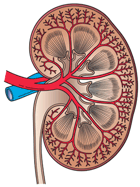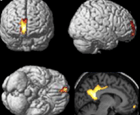 NRx (formerly known as Net Results Express) is UHN's monthly research e-newsletter. Through NRx you can read about ongoing research at our five research institutes, the Ontario Cancer Institute (OCI), the Toronto General Research Institute (TGRI), the Toronto Western Research Institute (TWRI), the Toronto Rehabilitation Institute (TRI) and the Techna Institute (Techna).
NRx (formerly known as Net Results Express) is UHN's monthly research e-newsletter. Through NRx you can read about ongoing research at our five research institutes, the Ontario Cancer Institute (OCI), the Toronto General Research Institute (TGRI), the Toronto Western Research Institute (TWRI), the Toronto Rehabilitation Institute (TRI) and the Techna Institute (Techna).
In this issue you can read about research in:
- A potential cause of relapse in multiple myeloma
- Predicting mortality in liver cirrhosis
- Reversing symptoms of neurological disorders
- Impulsive behaviour in Parkinson's disease
- The immune system in destroying tumour cells
- Barriers preventing cardiac rehabilitation
We hope that you will find NRx informative. If you have feedback or questions, please contact www@uhnresearch.ca.
Christopher J. Paige, PhD, FCAHS
Vice President, Research
University Health Network

Dr. Tiedemann’s discovery was featured on the cover of Cancer Cell.
Multiple myeloma (MM) is an incurable cancer of the bone marrow that persistently recurs after initial treatment. To understand why treatments fail to cure MM, OCI Scientist Dr. Rodger Tiedemann has examined how MM resists current treatment and recurs.
The research demonstrates that the progenitor cells—descendants of stem cells that turn into specific cell types—are untouched by mainstay therapy. Standard treatment is the use of a proteosome inhibitor (PI), a class of drugs that cause cell death, that typically destroys the bulk of the cells that make up most of the tumour. Their findings showed that progenitor cells proliferate and mature to reboot the disease process, even in patients who appear to be in complete remission.
Dr. Tiedemann says, "If you think of MM as a weed, then PIs are like a persnickety goat that eats the mature foliage above ground, producing a remission, but doesn’t eat the roots, so that one day the weed returns."
In tackling the dilemma of treatment failure, the researchers identified a cancer cell maturation hierarchy within MM and demonstrated the critical role of myeloma cell maturation in PI sensitivity. The implication is clear for current drug research focused on developing new PIs—targeting this route alone will never cure MM.
This work was supported by the Canadian Cancer Society, the Molly and David Bloom Chair in Multiple Myeloma Research, the Arthur Macaulay Cushing Estate and The Princess Margaret Cancer Foundation.
Xbp1s-negative tumor B cells and pre-plasmablasts mediate therapeutic proteasome inhibitor resistance in multiple myeloma. Leung-Hagesteijn C, Erdmann N, Cheung G, Keats JJ, Stewart AK, Reece DE, Chung KC, Tiedemann RE. Cancer Cell. 2013 September 9. [Pubmed abstract]

Renal dysfunction is a common complication of liver cirrhosis that is believed to be the result of altered blood flow in the kidneys (above).
A recent study by TGRI Affiliate Scientist Dr. Florence Wong, along with international collaborators on behalf of the North American Consortium in the Study of End-Stage Liver Disease, presents compelling new evidence that acute kidney injury (AKI) is an accurate predictor of mortality, length of hospital stay and organ failure in patients with liver cirrhosis. The prospective study followed patients with cirrhosis who were hospitalized with a bacterial infection—renal failure is commonly precipitated by bacterial infection in these patients—and data was compared between patients with and without AKI. Results showed that higher percentages of patients with AKI were transferred to the intensive care unit, required ventilation, went into shock and had longer stays in the hospital. Moreover, in patients with cirrhosis and infection whose AKI did not improve, mortality rates were ten-fold higher within 30 days of hospitalization compared to patients without AKI.
"AKI, as determined using the criteria in this study, is an accurate predictor of the development of adverse outcomes in this patient population," explains Dr. Wong. "Thus, future studies should target preventive measures of AKI according to these criteria."
This work was supported by the National Institutes of Health and the National Center for Research Resources .
New consensus definition of acute kidney injury accurately predicts 30-day mortality in patients with cirrhosis with infection. Wong F, O’Leary JG, Reddy KR, Patton H, Kamath PS, Fallon MB, Garcia-Tsao G, Subramanian RM, Malik R, Maliakkal B, Thacker LR, Bajaj JS. Gastroenterology. 2013 August 30. [Pubmed abstract]

Rett syndrome occurs mainly in women and leads to complete loss of verbal skills and, in about half of individuals, the ability to walk.
A number of neurological disorders, including Rett syndrome, X-linked mental retardation and Angelmann syndrome have a common underlying cause. These conditions, which lead to reduced lifespan and symptoms similar to autism and cerebral palsy, are associated with genetic mutations that compromise the function of the gene known as Methyl-CpG-binding protein 2 (MeCP2).
While these disorders are life-long, studies have shown that restoration of MeCP2 function may reverse certain symptoms. TWRI Senior Scientist Dr. James Eubanks and TWRI Affiliate Scientist Dr. Liang Zhang have extended these findings by revealing the impact of MeCP2 restoration on a broad range of related symptoms. Using a mouse model of Rett syndrome, Dr. Eubanks repaired MeCP2 function in mice after they reached adulthood and found significant improvements in lifespan, behaviour and nervous system function.
Dr. Eubanks explains, "Because alteration of MeCP2 gene function is thought to arrest the development of certain neurons, these results support the possibility that restoration of MeCP2 function in adults allows these immature neurons to resume development. These exciting results lay the foundation for future therapies for patients with Rett and related syndromes."
This work was supported by the Canadian Institutes of Health Research and the Ontario Rett Syndrome Association.
Rescue of behavioral and EEG deficits in male and female Mecp2-deficient mice by delayed Mecp2 gene reactivation. Lang M, Wither RG, Colic S, Wu C, Monnier PP, Bardakjian BL, Zhang L, Eubanks JH. Human Molecular Genetics. 2013 September 17. [Pubmed abstract]

The functional PET imaging used in this study tracks the changes in blood flow associated with brain activity.
People with Parkinson's disease have a tendency to be more impulsive, though it is not known whether that is an effect of the disease itself or the medication used to treat it. Drugs that activate dopamine receptors in the brain are some of the most common treatments for the symptoms of this disease, and the involvement of dopamine in the brain's reward circuitry suggests that they may be, in part, responsible for this behaviour. TWRI Senior Scientist Dr. Antonio Strafella recently investigated the effects of one drug (pramipexole) on impulsivity in Parkinson's patients.
Dr. Strafella and colleagues used psychological tests to separately analyze different aspects of impulsivity: the likelihood of making impulsive choices or of making impulsive movements. Pramipexole affected choices that depended on valuing a reward in the future, leading to subjects preferring a small reward with instant gratification, rather than waiting for a larger one. The drug did not influence the ability to prevent impulsive movements.
Using positron emission tomography (PET) functional imaging, the team confirmed that pramipexole altered brain activity in regions associated with decision-making and making judgments about the future.
This work was supported by the Canadian Institutes of Health Research. A. Strafella is a Tier 2 Canada Research Chair in Movement Disorders & Neuroimaging.
Dopamine-agonists and impulsivity in Parkinson's disease: Impulsive choices vs. impulsive actions. Antonelli F, Ko JH, Miyasaki J, Lang AE, Houle S, Valzania F, Ray NJ, Strafella AP. Human Brain Mapping. 2013 September 3. [Pubmed abstract]

TRAIL proteins bind to a specific receptor on the surface of tumour cells to induce cell death.
TGRI Senior Scientist Dr. Li Zhang and OCI Senior Scientist Dr. Ming-Sound Tsao have discovered a new mechanism by which a type of immune cell—known as a gamma delta T cell—recognizes and kills cancer cells.
This discovery builds upon previous research by Dr. Zhang and her collaborators which showed that lymphoid cells are able to kill cancer cells by increasing the expression of a protein called TNF-related apoptosis-inducing ligand (TRAIL). The more recent study demonstrates that the ability of gamma delta T cells to regulate cancer cell death is controlled by the function of a protein called Natural Killer receptor group 2 member D (NKG2D). When NKGD2 is activated, it induces soluble TRAIL production and release, which then leads to tumour cell death.
The findings from this study help to establish the mechanisms by which gamma delta T cells exert anti-tumour activity and may be useful in developing immunity-based cancer treatments.
This work was supported by the Canadian Institutes of Health Research.
Dokouhaki P, Schuh NW, Joe B, Allen CA, Der SD, Tsao MS, Zhang L. NKG2D regulates production of soluble TRAIL by ex vivo-expanded human gamma delta T cells. European Journal of Immunology. 2013 August 20. [Pubmed abstract]

Rural patients were defined as those having to drive over 30 minutes to their cardiac rehabilitation site.
Cardiac rehabilitation programs for patients with heart disease can reduce mortality by 25% and improve quality of life. Despite these benefits, cardiac rehabilitation is often underused. In particular, people of low socioeconomic status or living in a rural environment are less likely to undertake these programs. Consequently, these people are at a greater risk of suffering from the long-term consequences of heart disease.
To better understand the causes behind the lack of enrollment in cardiac rehabilitation programs among these groups, TRI Adjunct Scientist, TGRI Scientist and York University Associate Professor Dr. Sherry Grace, PhD student Susan Marzolini Shamila Shanmugasegaram and TRI Scientist Dr. Paul Oh conducted a study of heart disease patients to identify the barriers preventing them from participating, using a scale they had developed. They found that the barriers preventing participation were lack of physician referral, the distance to the site of rehabilitation care, costs associated with getting to rehabilitation and transportation problems.
Commenting on the findings of this study, Dr. Grace says, "It is time for broader application of proven strategies to promote equitable cardiac rehabilitation referral, and to offer home-based programs to address the barriers for these vulnerable subpopulations of patients."
Cardiac rehabilitation barriers by rurality and socioeconomic status: a cross-sectional study. Shanmugasegaram S, Oh P, Reid RD, McCumber T, Grace SL. International Journal for Equity in Health. 2013 August 28. [Pubmed abstract]
 TWRI Director Dr.
TWRI Director Dr.  TWRI Senior Scientist and Head of the Division of Brain, Imaging & Behaviour - Systems Neuroscience Dr.
TWRI Senior Scientist and Head of the Division of Brain, Imaging & Behaviour - Systems Neuroscience Dr.